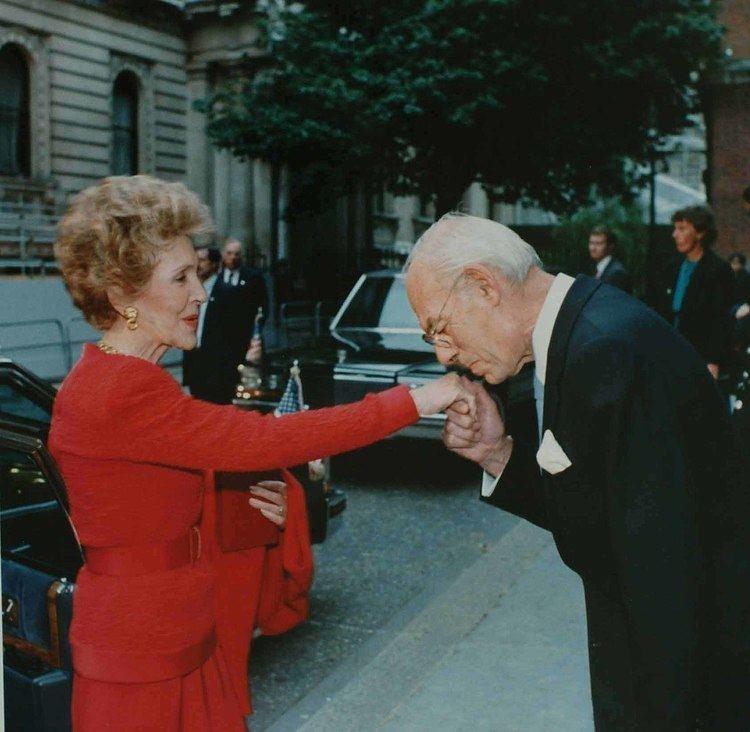 | ||
Similar Hat tip, Head bobble, Mano (gesture) | ||
Hand-kissing is a gesture indicating courtesy, politeness, respect, admiration or even devotion by one person toward another.
Contents
A hand-kiss is initiated by the person receiving the greeting by holding out their hand with the palm facing downward; or by the person giving the greeting, by extending a hand to grasp the recipient's hand. The person kissing bows towards the offered hand and (often symbolically) touches the knuckles with their lips, while lightly holding the offered hand. However, the lips do not actually touch the hand in modern tradition, especially in a formal environment where any intimate or romantic undertones could be vastly inappropriate. The gesture is short, lasting less than a second.
Hand-kissing has become rare and is mostly restricted to the conservative upper class or diplomats.
In Turkey, Malaysia, Indonesia, and Brunei, hand-kissing is a common way to greet elder people of both genders, primarily the closest relatives (both parents, grandparents, and uncles or aunts) and teachers. Occasionally, after kissing the hand, the greeter will draw the hand to his own forehead.
The hand-kiss is used quite prominently in The Godfather series, as a way to indicate the person who is the Don. It also features in epoch films, such as Dangerous Liaisons.
Chivalrous gesture
A hand-kiss was considered a respectful way for gentleman to greet a lady. The practice originated in the Polish-Lithuanian Commonwealth and the Spanish courts of the 17th and 18th centuries. The gesture is still at times observed in Central and Eastern Europe, namely, Poland, Austria, Hungary, Slovakia, Romania and Russia.
Traditionally, the hand-kiss was initiated by a woman, who offered her hand to a man to kiss. The lady offering her hand was expected to be of the same or higher social status than the man. It was a gesture of courtesy and extreme politeness, and it was considered impolite and even rude to refuse an offered hand. Today, the practice is very uncommon in Northern European countries, and has been largely replaced by a kiss on the cheek or a handshake.
Today, the hand-kiss is sometimes used as a romantic gesture, usually in parting and usually initiated by a man. It could be used to convey a feeling of a more traditional and emotional attraction, rather than a superficial one that has become a stereotype of the 21st century. The gesture could be misconstrued as a parody or mockery of the original gesture, and indeed at times it may be used as such, but this is not always the sole intention. For example, it would not be mockery for a man saying goodnight to his girlfriend to kiss her hand, but a person who greatly exaggerated the practice would be clearly seen as mocking it as well as the person whose hand is being kissed.
Gesture of fidelity
It was also a gesture of formal submission or pledge of allegiance of man to man or as a diplomatic gesture. The gesture would indicate submission by kissing the signet ring (a form of seal worn as a jewelry ring), the person's symbol of authority. The gesture was common in the European upper class throughout the 18th and 19th centuries. It started to disappear in the 20th century, to be replaced by the egalitarian hand shake. However, former French president Jacques Chirac made hand-kissing his trademark and the gesture is still encountered in diplomatic situations.
Religious usage
In the Roman Catholic Church, a Catholic meeting the Pope or a Cardinal, or even a lower-ranking prelate, will kiss the ring on his hand. This has become uncommon in circles not used to formal protocol, even often dispensed with amongst clergy. Sometimes, the devout Catholic combines the hand kissing with kneeling on the left knee as an even stronger expression of filial respect for the clerically high-ranking father. The cleric may then in a fatherly way lay his other hand on the kisser's head or even bless him/her by a manual cross sign. In the Catholic Church, it is also traditional for the laity to kiss the hands of a newly-ordained priest after his inaugural mass, in veneration of the Body of Christ, which is held in the priest's hands during the Holy Eucharist.
In the Eastern Orthodox Church, it is appropriate and common for laity to greet clergy, whether priests or bishops, by making a profound bow and saying, "Father, bless" (to a priest) or "Master, bless" (to a bishop) while placing their right hand, palm up, in front of their bodies. The priest then blesses them with the sign of the cross and then places his hand in theirs, offering the opportunity to kiss his hand. Orthodox Christians kiss their priest's hands not only to honor their spiritual father confessor, but in veneration of the Body of Christ which the priest handles during the Divine Liturgy as he prepares Holy Communion. It is also a common practice when writing a letter to a priest to begin with the words "Father Bless" rather than "Dear Father" and end the letter with the words "Kissing your right hand" rather than "Sincerely."
During liturgical services, altar servers and lower clergy will kiss the hand of a priest when handing him something in the course of their duties, such as a censer, when he receives it in his right hand, and a bishop when he receives it in either hand since a bishop bestows blessings with both hands.
There are records of hand-kissing in the Islamic Caliphate as early as the 7th century.
